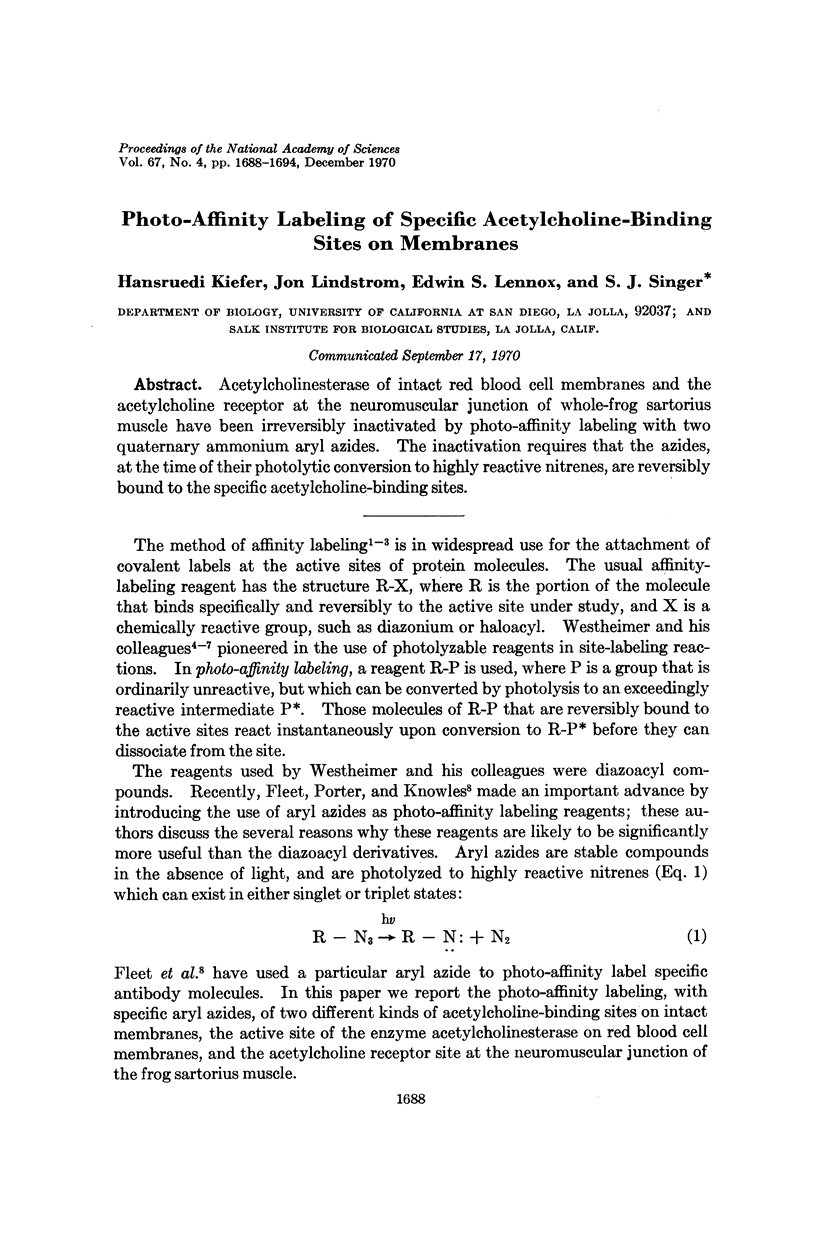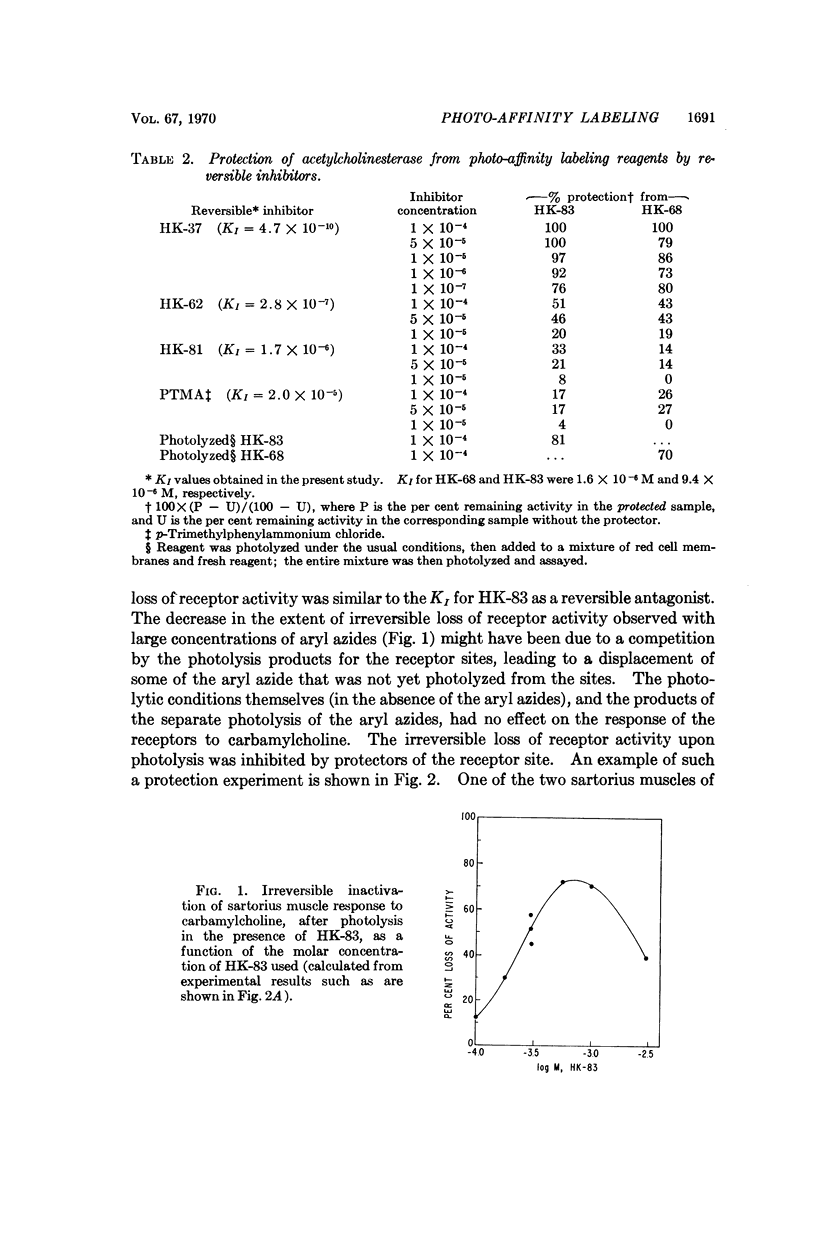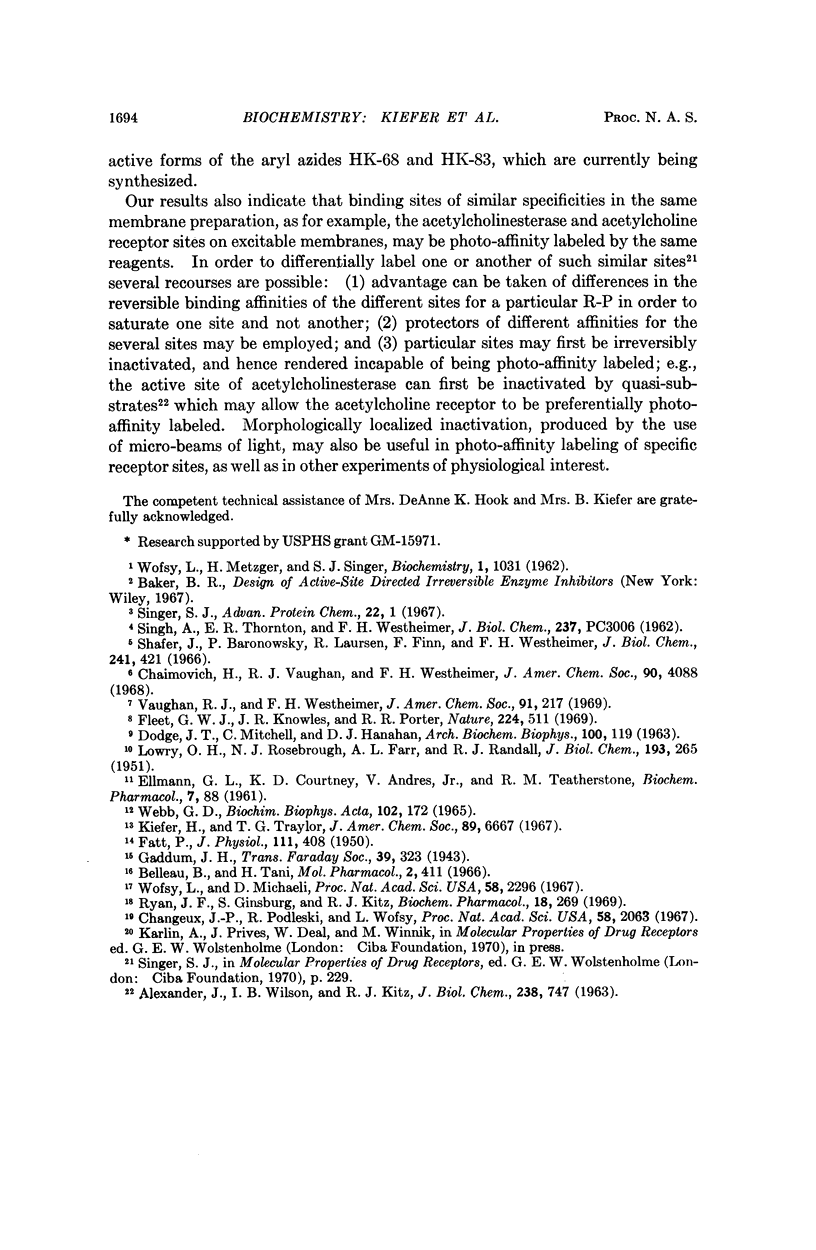Abstract
Acetylcholinesterase of intact red blood cell membranes and the acetylcholine receptor at the neuromuscular junction of whole-frog sartorius muscle have been irreversibly inactivated by photo-affinity labeling with two quaternary ammonium aryl azides. The inactivation requires that the azides, at the time of their photolytic conversion to highly reactive nitrenes, are reversibly bound to the specific acetylcholine-binding sites.
Full text
PDF






Selected References
These references are in PubMed. This may not be the complete list of references from this article.
- Belleau B., Tani H. A novel irreversible inhibitor of acetylcholinesterase specifically directed at the anionic binding site: structure-activity relationships. Mol Pharmacol. 1966 Sep;2(5):411–422. [PubMed] [Google Scholar]
- Changeux J. P., Podleski T. R., Wofsy L. Affinity labeling of the acetylcholine-receptor. Proc Natl Acad Sci U S A. 1967 Nov;58(5):2063–2070. doi: 10.1073/pnas.58.5.2063. [DOI] [PMC free article] [PubMed] [Google Scholar]
- DODGE J. T., MITCHELL C., HANAHAN D. J. The preparation and chemical characteristics of hemoglobin-free ghosts of human erythrocytes. Arch Biochem Biophys. 1963 Jan;100:119–130. doi: 10.1016/0003-9861(63)90042-0. [DOI] [PubMed] [Google Scholar]
- ELLMAN G. L., COURTNEY K. D., ANDRES V., Jr, FEATHER-STONE R. M. A new and rapid colorimetric determination of acetylcholinesterase activity. Biochem Pharmacol. 1961 Jul;7:88–95. doi: 10.1016/0006-2952(61)90145-9. [DOI] [PubMed] [Google Scholar]
- FATT P. The electromotive action of acetylcholine at the motor end-plate. J Physiol. 1950 Oct 16;111(3-4):408–422. doi: 10.1113/jphysiol.1950.sp004492. [DOI] [PMC free article] [PubMed] [Google Scholar]
- LOWRY O. H., ROSEBROUGH N. J., FARR A. L., RANDALL R. J. Protein measurement with the Folin phenol reagent. J Biol Chem. 1951 Nov;193(1):265–275. [PubMed] [Google Scholar]
- Ryan J. F., Ginsburg S., Kitz R. J. The reaction of acetylcholinesterase with methanesulfonyl esters of quaternary quinolinium compounds. Biochem Pharmacol. 1969 Feb;18(2):269–278. doi: 10.1016/0006-2952(69)90204-4. [DOI] [PubMed] [Google Scholar]
- Shafer J., Baronowsky P., Laursen R., Finn F., Westheimer F. H. Products from the photolysis of diazoacetyl chymotrypsin. J Biol Chem. 1966 Jan 25;241(2):421–427. [PubMed] [Google Scholar]
- Singer S. J. Affinity labelling of protein active sites. In: Molecular properties of drug receptors. Ciba Found Symp. 1970:229–246. doi: 10.1002/9780470719763.ch11. [DOI] [PubMed] [Google Scholar]
- Singer S. J. Covalent labeling of active sites. Adv Protein Chem. 1967;22:1–54. doi: 10.1016/s0065-3233(08)60040-6. [DOI] [PubMed] [Google Scholar]
- Vaughan R. J., Westheimer F. H. A method for marking the hydrophobic binding sites of enzymes. An insertion into the methyl group of an alanine residue of trypsin. J Am Chem Soc. 1969 Jan 1;91(1):217–218. doi: 10.1021/ja01029a055. [DOI] [PubMed] [Google Scholar]
- WOFSY L., METZGER H., SINGER S. J. Affinity labeling-a general method for labeling the active sites of antibody and enzyme molecules. Biochemistry. 1962 Nov;1:1031–1039. doi: 10.1021/bi00912a013. [DOI] [PubMed] [Google Scholar]
- Webb G. D. Affinity of benzoquinonium and ambenonium derivatives for the acetylcholine receptor, tested on the electroplax, and for acetylcholinesterase in solution. Biochim Biophys Acta. 1965 May 25;102(1):172–184. doi: 10.1016/0926-6585(65)90211-6. [DOI] [PubMed] [Google Scholar]
- Wofsy L., Michaeli D. Affinity labeling of the anionic site of acetylcholinesterase. Proc Natl Acad Sci U S A. 1967 Dec;58(6):2296–2298. doi: 10.1073/pnas.58.6.2296. [DOI] [PMC free article] [PubMed] [Google Scholar]


